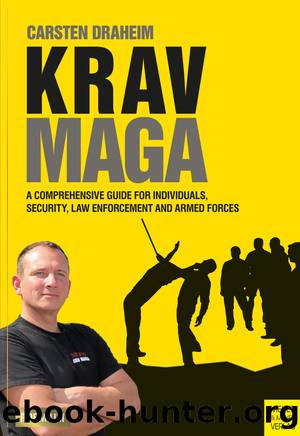Krav Maga: A Comprehensive Guide for Individuals, Security, Law Enforcement and Armed Forces by Carsten Draheim

Author:Carsten Draheim [Draheim, Carsten]
Language: eng
Format: epub
Tags: Sports & Recreation, Martial Arts, General
ISBN: 9781782554288
Google: 7Lp4DwAAQBAJ
Publisher: Meyer & Meyer Sport
Published: 2017-04-01T23:30:19.036247+00:00
Forms of sparring include:
1. Slow Fight â The opponents fight each other slowly. This does not only apply to a one-on-one situation but can and should involve multiple attackers against one defender. Slow means an attack and defense take place every two seconds, almost in slow motion. When reading this it is hard to believe how stressful this can be for the defender in a five-on-one situation. Here the focus is on learning the proper distances; direct hits are absolutely encouraged, but should be slow and controlled. The emphasis is on tactical behavior, particularly with multiple attackers: Get off the line of attack and donât get into the next one: Donât go through the middle of the attackers but move counter-cyclically along the outside. To the observer these slow movements look rather more like a dance and I have seen many a combat athlete stand and watch with a chuckle.
However, everyone starts out slow and although it is about internalizing motion sequences, it is also about early recognition of distances and attacks. To the defender the movement pattern of a straight right punch always looks the same, regardless of whether it is executed at full speed or in slow motion. In other words, as far as memorability is concerned, it makes no difference whether the punch is fast or slow to internalize motion sequences. These patterns must be recognized and defense strategies must be developed to counter them.
This development occurs much more quickly in a slow fight than, for instance, during boxing training in a ring. The inexperienced person scores one hit after another when sparring with an experienced boxer, without really understanding why. Maybe because he is quick and because he hits him in unexpected places. Even his coach, who is yelling âGuard!â from the corner of the ring, isnât much help here because he lacks knowledge about punches or punch combinations.
Because experienced fighters in Krav Maga occasionally meet up with inexperienced ones the slow fight is a good opportunity for relatively harmless copying and trying out of skills. But that doesnât mean that you canât come away with the odd black eye. Slow fighting is a good exercise for the previously defined Retzev concept. Slow fighting is meant to improve the flow of the attacks during a fight, and movements should be intuitive and automated without having to think about the next movement during a fight.
The environment can be a source of additional stress, for instance strobe lights and loud music along with restricted spatial vision. Also suitable here are obstructions that can occur in an actual fight situation and are announced by the trainer, such as losing the use of the right arm because it is broken, the left eye is swollen shut and covered with tape, or the nose is broken and taped up, just to mention a few.
Photo 35: Training in a dark room with strobe lights, loud music, and multiple attackers against one defender equals stress!
Download
This site does not store any files on its server. We only index and link to content provided by other sites. Please contact the content providers to delete copyright contents if any and email us, we'll remove relevant links or contents immediately.
Spare by Prince Harry The Duke of Sussex(5077)
Machine Learning at Scale with H2O by Gregory Keys | David Whiting(4194)
Fairy Tale by Stephen King(3222)
Will by Will Smith(2795)
Hooked: A Dark, Contemporary Romance (Never After Series) by Emily McIntire(2502)
The Bullet Journal Method by Ryder Carroll(2487)
Rationality by Steven Pinker(2291)
Can't Hurt Me: Master Your Mind and Defy the Odds - Clean Edition by David Goggins(2230)
It Starts With Us (It Ends with Us #2) by Colleen Hoover(2203)
Friends, Lovers, and the Big Terrible Thing by Matthew Perry(2126)
The Becoming by Nora Roberts(2091)
Love on the Brain by Ali Hazelwood(1965)
HBR's 10 Must Reads 2022 by Harvard Business Review(1779)
The Strength In Our Scars by Bianca Sparacino(1778)
A Short History of War by Jeremy Black(1764)
Leviathan Falls (The Expanse Book 9) by James S. A. Corey(1651)
515945210 by Unknown(1602)
A Game of Thrones (The Illustrated Edition) by George R. R. Martin(1594)
Bewilderment by Richard Powers(1541)
